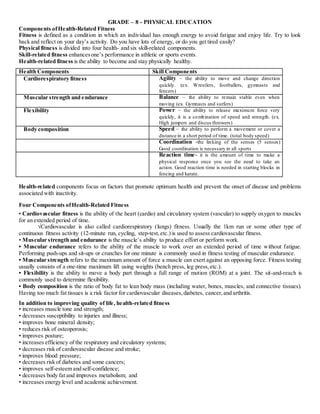english module
- 1. GRADE â 8 - PHYSICAL EDUCATION Components of Health-Related Fitness Fitness is defined as a condition in which an individual has enough energy to avoid fatigue and enjoy life. Try to look back and reflect on your dayâs activity. Do you have lots of energy, or do you get tired easily? Physical fitness is divided into four health- and six skill-related components. Skill-related fitness enhances oneâs performance in athletic or sports events. Health-related fitness is the ability to become and stay physically healthy. Health Components Skill Components Cardiorespiratory fitness Agility â the ability to move and change direction quickly. (ex. Wrestlers, footballers, gymnasts and fencers) Muscular strength and endurance Balance â the ability to remain stable even when moving (ex. Gymnasts and surfers) Flexibility Power â the ability to release maximum force very quickly, it is a combination of speed and strength. (ex. High jumpers and discus throwers) Body composition Speed â the ability to perform a movement or cover a distance in a short period of time. (total body speed) Coordination -the linking of the senses (5 senses) Good coordination is necessary in all sports Reaction time- it is the amount of time to make a physical response once you see the need to take an action. Good reaction time is needed in starting blocks in fencing and karate. Health-related components focus on factors that promote optimum health and prevent the onset of disease and problems associated with inactivity. Four Components of Health-Related Fitness âĒ Cardiovascular fitness is the ability of the heart (cardio) and circulatory system (vascular) to supply oxygen to muscles for an extended period of time. âCardiovascular is also called cardiorespiratory (lungs) fitness. Usually the 1km run or some other type of continuous fitness activity (12-minute run, cycling, step-test, etc.) is used to assess cardiovascular fitness. âĒ Muscular strength and endurance is the muscleâs ability to produce effort or perform work. âĒ Muscular e ndurance refers to the ability of the muscle to work over an extended period of time without fatigue. Performing push-ups and sit-ups or crunches for one minute is commonly used in fitness testing of muscular endurance. âĒ Mus cular s tre ngth refers to the maximum amount of force a muscle can exert against an opposing force. Fitness testing usually consists of a one-time maximum lift using weights (bench press, leg press, etc.). âĒ Flexibility is the ability to move a body part through a full range of motion (ROM) at a joint. The sit-and-reach is commonly used to determine flexibility. âĒ Body compos ition is the ratio of body fat to lean body mass (including water, bones, muscles, and connective tissues). Having too much fat tissues is a risk factor for cardiovascular diseases, diabetes, cancer, and arthritis. In addition to improving quality of life, health-related fitness âĒ increases muscle tone and strength; âĒ decreases susceptibility to injuries and illness; âĒ improves bone mineral density; âĒ reduces risk of osteoporosis; âĒ improves posture; âĒ increases efficiency of the respiratory and circulatory systems; âĒ decreases risk of cardiovascular disease and stroke; âĒ improves blood pressure; âĒ decreases risk of diabetes and some cancers; âĒ improves self-esteem and self-confidence; âĒ decreases body fat and improves metabolism; and âĒ increases energy level and academic achievement.
